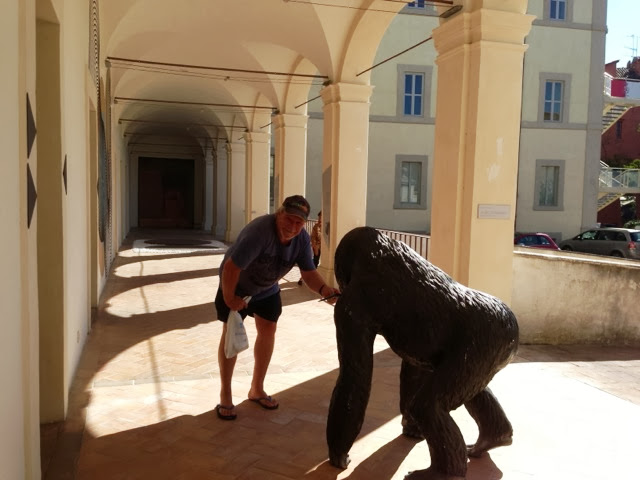Some places are very difficult to photograph. Spoleto is one of those. It sits gently in its landscape and even though it is high up and quite steep internally, it is not like a typical medieval hill-town. It is a bit like a layer of thick chocolate icing on top of a cupcake, with a square cherry on the top.
I think this photograph which Paul took from the highway as we left, is as good as we were able to get. The bulk of the city is to the left and the fortress sits on the highest part of the hill with the road running through the river valley below.
The fortress is officially called the Rocca Albornoziana di Spoleto. It was commissioned to be built around 1360 to form a papal stronghold and win back papal territories in the region. This was the era when the papacy had lost control of power in Rome and had retreated to Avignon in France - hence the Palace of the Popes in Avignon and lots of associated development in that area such as Chateauneuf du Pape, the wine area on the Rhone.
But back to the Rocca - the pope who commissioned the Rocca was from a Spoleto family so it was in his interest to have a strong fortress in his seat of power. The original building was half the size of the one you see today. Extensions and renovations took place continually.
The fortress was serviced by an aqueduct carrying water from springs in the mountain across the valley of the river Clitunno.
This time the aqueduct is medieval rather than Roman. The spring water was sourced and managed at the tower across the valley and was channeled into the lower part of the fortress, where it was mechanically pumped/lifted up through the building to the well in the courtyard.
This is the courtyard with a decorative structure around the well, added much later than the original, handsome colonnaded upper and lower galleries.
There are magnificent views of the city from the upper gallery. The building's role as a fortress waned and it became the seat of the Dukes of Spoleto and the Governor of the Duchy. But eventually the Governor moved into the town and from 1817 until 1982, the fortress was a high security prison before its transfer to the Department of Heritage and its rebirth as the National Museum of the Duchy of Spoleto.
We first arrived in Spoleto in the late afternoon and our first walk from the hotel into the central area of the city took us through this graceful park just as the lights came on at dusk.
Mosts weeks of the year the city hosts cultural events for the community. On this particular evening it was a dinner in the park, catered by one of the city's restaurants and open to anyone who was willing to to pre-book (and pay, of course). The following day it was a two act play (unfortunately for me, in Italian) for an entrance price of 5€.
Our first day of discovering the city turned up this excavated Roman theatre which I hope to make the focus of another blog. It and its Archeological Museum were very interesting. The seating and the semi-circular orchestra area are well preserved. But the stage and back-stage area were damaged when the church (tall, large grey mass on right) was originally built in the 13th C. Lots more in next post.
Spoletto is spotlessly clean and in good repair, especially in the main inner city areas.
Doors, mailboxes, steps, planters ......
The inner city road leads uphill with cafes in the shade at the sides.
This is the large piazza in front of the cathedral and, at festival time, it hosts many recitals and performances, crammed with people on seats and sitting on the wide steps leading forever upwards. This is the main tourist drag but it remains almost pristine. There is absolutely no advertising anywhere in the historical city - except for traditional posters advertising cultural events and the Festival.
If Juliet hadn't had her tiny curved balcony, she could have pined for Romeo from this handsome crossover number.
There is sculpture everywhere. Although I didn't read about it, I suspect they have a bi- or tri- annual sculpture competition and the city gets to display the winners - like this one.
The town hall and council headquarters and civic piazza.
The municipal vehicle fleet? Or is it the mayor's car? A Smart 2x2.
Obviously, the mayor can't drive everywhere.
Paul playing 'tease the gorilla' in front of an art gallery called - The Palazzo Collicola Arti Visive and the Appartamento Nobile.
The Appartamento Nobile was a restored gentleman's residence or palazzo of the 16thC. It was beautiful with marble doorways, exquisite parquetry and stone floors and a world famous collection of wall tables.
A wide variety of old and new pieces were displayed together.
This glorious glassed in verandah faced west - OK in Winter but I don't know how they have retained the decoration all these years given the 40°+ on the Summer day we visited.
A section of painted, wooden ceiling.
This bronze and plastic work was exhibited on the floor and entitled 'Hermes Resting'.
A novel display of contemporary drawings.
An inlaid wooden cabinet. It's not paint - it's all wood.
Three walls of a stairwell. It had something to do with patronage for street art. This painter was Spanish.
Brilliant - but a bit scary!




























No comments:
Post a Comment